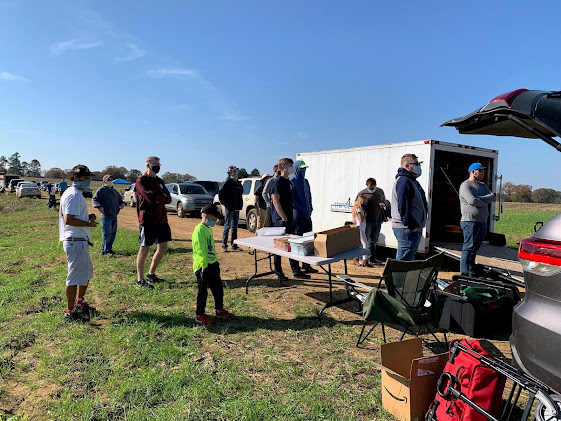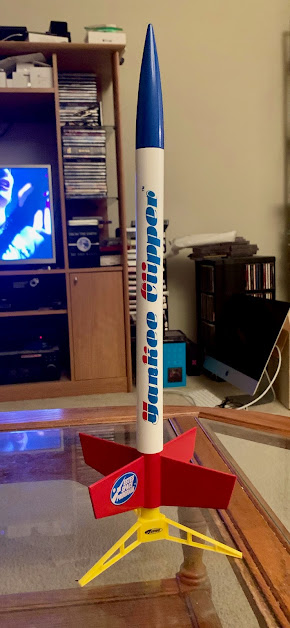 |
My LGM lies on the ground after its fall (Click to enlarge).
|
Yesterday was a very nice day, perfect rocket flying weather - clear sky, no wind, and an afternoon high of 70 degrees. So Duane and I packed our stuff and headed out to Pegasus field to launch a few rockets before the Thanksgiving holidays begin. Greg and Josh joined us, and there were quite a few launchings. The up parts generally went OK... Not so much with the landings. The short summary is that Duane and I had terrible luck on the field, and I hope it doesn't stick around for the next launch.
The first rocket off the pad was my new Estes Centurion, a foam rocket styled like a space fighter. It looks pretty darn sharp, and flew low but straight on an Estes A8-3.
 |  |
Centurion on pad (Click to enlarge).
| Centurion clears the rod (Click to enlarge).
|
Duane's 2019 Christmas rocket followed mine, heading up into the blue on a D12-3. We saw the model arc over and waited for ejection to occur. And waited, and waited, and waited... Right up to the point where the rocket smacked headlong into the ground, popping a fin off and squishing old Frosty's head pretty good. Damage is repairable, but I bet the snowman has a terrible headache.
 |  |
Duane with his Xmas rocket
(Click to enlarge).
| Up, up, and away (Click to enlarge)!
|
 |  |
| Frosty has a headache (Click to enlarge)! | Greg shows off his Star Wars outfit
(Click to enlarge).
|
Next was Greg. He brought his 1990's retro Estes Naboo fighter, complete with pad and R2-D2 controller. Up it went and it came down safely under a partially deployed parachute. All in all, a good flight; kinda neat to see one of the old Estes Star Wars models fly.
Duane's Cherokee F is always a crowd pleaser, being an very nice looking upscale of the Estes model (Have I mentioned that Duane is a Cherokee fanatic, with several versions in his rocket stable?). This time it was prepped with an Aerotech F52 reload and a Jolly Logic Chute Release - which, as it turned out, would not be needed. In the saddest flight of the day, the forward closure of the motor case failed right after launch, separating the payload section from the sustainer - which was barbecued by the flame going forward through the rocket. I could not bear taking pictures of the aftermath; the fried remains were too pathetic. Needless to say, Duane was not a happy camper. But he soldiered on - and found yet more grief.
 |  |
The motor in the Cherokee-F ignites
(Click to enlarge).
| The payload section coupler appears as the
forward closure fails (Click to enlarge).
|
Josh had mixed luck yesterday - his 3D printed Y-Wing broke apart on a hard landing, but the Estes Multiroc had a pretty good flight (even found the glider). His Starbase Starcruiser flew well on a Q-Jet, but the lad has yet to perfect his cluster technique. Despite the use of low current Q2G2 igniters, only one motor in his NASA Deuces Wild lit, causing the model to arc over into the ground - just like it did at the club launch a couple of weeks ago. Everything went fine with the flight of the Fliskits ACME Spitfire, but his 2 stage Estes Supernova had a slight issue. The booster fit too tightly into the upper stage, so that the 2nd stage motor blew the lower motor right out the back of the first stage, scorching the booster a bit. It hung on throughout the flight.
 |  |
Josh's Y-Wing gets going (Click to enlarge).
| The Multiroc starts up the rod
(Click to enlarge).
|
 |  |
The Starbase Starcruiser rises on a black
pillar of smoke (Click to enlarge).
| Uh oh (Click to enlarge)!
|
 |  |
Josh's ACME Spitfire on a D12
(Click to enlarge).
| The 1st stage in the Supernova ignites
(Click to enlarge).
|
Duane hoped to reverse the recovery failure trend by flying one of his reliable TARC rockets. The model shot off the pad, attaining a respectable altitude. We saw it arc over and then heard the rocket whistle in as it plunged straight into the ground - it was buried so deep that Duane had to struggle to pull it from the Earth. As Dr. McCoy would say, "It was dead, Jim." I was beginning to feel extremely sorry for Duane, but, determined to have a successful flight, he pulled out his Estes Cherokee E and loaded it on the pad. It too flew straight as an arrow, but the parachute partially unfurled, and the rocket had a hard landing on the asphalt entrance to the Blue Origin parking lot. 2 fins broke off, - that was it for Duane. He sadly loaded his corpses and casualties into the SUV and watched the remaining few flights, refraining from some colorful language because of the presence of Josh and his mother.
 |  |
Duane hooks up the igniter (Click to enlarge).
| Duane's TARC rocket clears the rail
(Click to enlarge).
|
Which brings it back to me and my remaining two flights. These would not go as well as that of the Centurion.
In an attempt to get some HD footage of staging, I had outfitted my Estes LGM with a booster and the camera from the Estes Astrocam. The C11/B6 motor combination propelled the model to a decent altitude, but the old rubber shock cord broke at ejection, leaving the body/camera to fall horizontally (thank goodness!) and the nose cone to sail off into the sunset with my nice new Apogee nylon parachute. Fortunately, I was able to replace the nose cone but the camera footage did not yield anything useful. Apparently the camera was tilted just enough to miss the booster falling away.
 |  |
The LGM blasts off (Click to enlarge).
| My RX-16 under Q-Jet power
(Click to enlarge).
|
 |
Frame showing staging from camera on the LGM (Click to enlarge).
|
All the failures of the day caused me to look long and hard at my Centuri RX-16 clone, which was loaded with a Quest D16 and about $200 in electronics (FlightSketch Mini altimeter and the PocketLab Voyager). The rocket had had a perfect flight at the HARA launch, so I figured I'd give it a go. I almost backed out as I loaded the model on the pad, but talked myself into proceeding. The rocket sped up into the blue sky and I breathed a sigh of relief when I saw the orange nylon parachute come free. However, it would not open - the rocket kept falling and the parachute stayed closed, wriggling about as if to say "Should have not done this." The RX-16 hit the ground hard enough to break a fin, adding another strand to the day's awful string of recovery failures. Even worse, the landing jarred the altimeter, which gave nonsense readings of negative 500 feet. And then, flustered as I was, I must have accidentally wiped the PocketLab's memory trying to download the data into my laptop. Sigh...
I laid my casualties next to Duane's in the vehicle, and we left the field wondering how such a beautiful day could give birth to enormous carnage. The RX-16 repair is under way, and I am still trying to figure out how I wiped the Voyager's memory. In a way, I envy the Voyager - a memory wipe of yesterday from my brain would be good.
Here's hoping the next launch goes better!









































